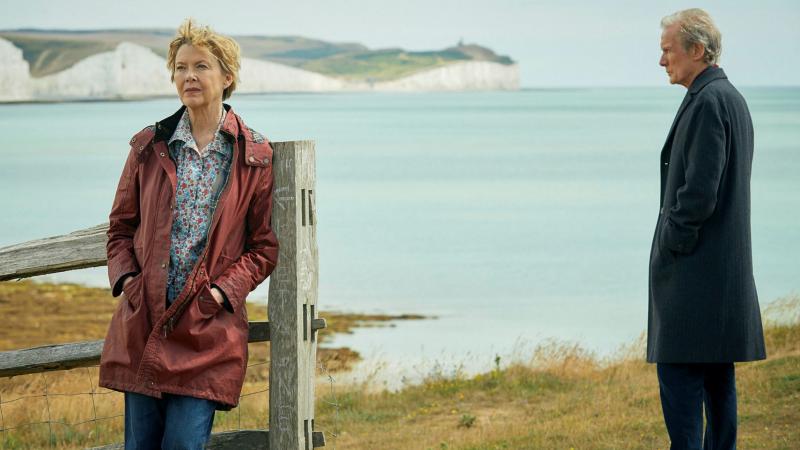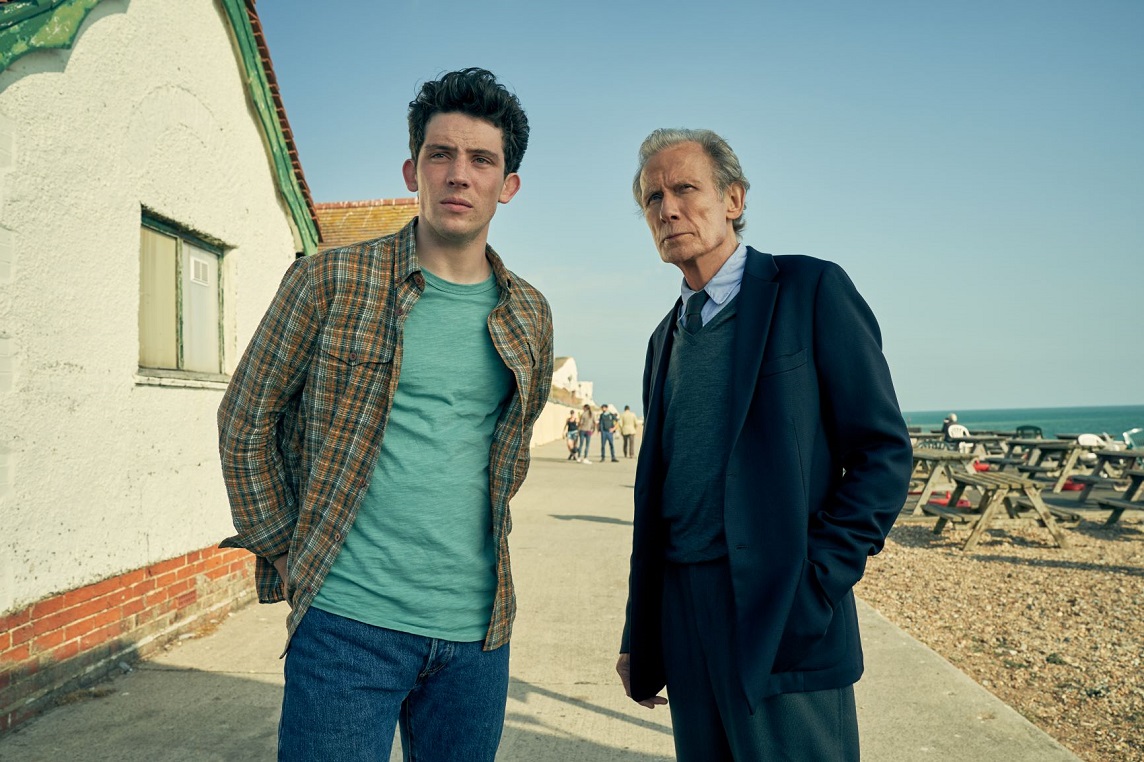Hope Gap review - memories of a marriage | reviews, news & interviews
Hope Gap review - memories of a marriage
Hope Gap review - memories of a marriage
Nighy and Bening animate a marital autopsy

William Nicholson’s Shadowlands screenplay was his most devastating expression of English repression. His second film as director goes to the source, in this fictionalised account of his parents’ divorce, which he waited till they were dead to make.
Grace is an unreasonable woman, Edward an over-reasonable man. The clockwork which let these opposite natures grind together for 29 years snaps suddenly. She hits him and tips over the kitchen table, in a film where suddenly popped toast otherwise counts as violent. His head jerks with anger when he’s slapped, revealing his suppression’s fierceness, the reaction she seeks almost rising. “It’s like somehow you sneaked away when I wasn’t looking,” she complains, baffled by an absence she can’t place, an emotional removal now past recovery. Instead he really leaves for another woman. “It was me she touched,” he tells Jamie of this simpler love, relaxing at last.
 Aerial shots sweep over the Seven Sisters cliffs, and Seaford’s hinterland is wandered with practised ease: the meadows towards the Downs and the fatal pull of cliffs such as Beachy Head, a notorious suicide spot. Edward and Jamie are framed against Newhaven’s Napoleonic fort and coloured beach huts. The very ice cream Edward licks seems materialised from memories, a seaside Madeleine, as Nicholson sets down this Sussex of his mind. It’s here that his film has value. Though much was shot in Yorkshire and the studio, its primary landscape is a native son’s.
Aerial shots sweep over the Seven Sisters cliffs, and Seaford’s hinterland is wandered with practised ease: the meadows towards the Downs and the fatal pull of cliffs such as Beachy Head, a notorious suicide spot. Edward and Jamie are framed against Newhaven’s Napoleonic fort and coloured beach huts. The very ice cream Edward licks seems materialised from memories, a seaside Madeleine, as Nicholson sets down this Sussex of his mind. It’s here that his film has value. Though much was shot in Yorkshire and the studio, its primary landscape is a native son’s.
But having got in so close, Nicholson can’t see his script clear. Bening’s condition for working under his novice direction was to “mess up” her lines, and they need it. Based on his 1999 play Retreat from Moscow, every notion is theatrically loaded. “I suppose it’s because I don’t like things to end,” Grace says of her habit of not finishing tea, and the metaphors thud on.
 Bening and Nighy commit as best they can. She has a trademark abrasive set piece in a solicitor’s office (where the unpleasant English tradition of admiring cut-glass rudeness to underlings is revived), and turns coquettish to Jamie after outbursts, charm leavening her slashing impatience. Her punctilious English accent is off enough to sound drugged. Nighy focuses on how a husk would move. He’s bent over, his usual dryness tinderstick brittle, ready to crack and pop in his feelings’ forest fire. Both are worth watching. But they are finally animatronic versions of real people in Nicholson’s head. His finely turned words for them crowd in like overwrought carpentry, till nothing moves.
Bening and Nighy commit as best they can. She has a trademark abrasive set piece in a solicitor’s office (where the unpleasant English tradition of admiring cut-glass rudeness to underlings is revived), and turns coquettish to Jamie after outbursts, charm leavening her slashing impatience. Her punctilious English accent is off enough to sound drugged. Nighy focuses on how a husk would move. He’s bent over, his usual dryness tinderstick brittle, ready to crack and pop in his feelings’ forest fire. Both are worth watching. But they are finally animatronic versions of real people in Nicholson’s head. His finely turned words for them crowd in like overwrought carpentry, till nothing moves.
Only O’Connor, pictured above left, so good as a repressed gay Yorkshire hill farmer in God’s Own Country, is left room to breathe. Essentially playing the author as he participates in his family’s pain, Jamie’s own numbed repression shatters when talking to friends. Typifying Hope Gap’s blind spots, the modern youthful friends seem fake. But as Jamie breaks down, reality briefly bleeds into this fumbled film, whose heart otherwise stays withdrawn.
rating
Explore topics
Share this article
The future of Arts Journalism
You can stop theartsdesk.com closing!
We urgently need financing to survive. Our fundraising drive has thus far raised £49,000 but we need to reach £100,000 or we will be forced to close. Please contribute here: https://gofund.me/c3f6033d
And if you can forward this information to anyone who might assist, we’d be grateful.

Subscribe to theartsdesk.com
Thank you for continuing to read our work on theartsdesk.com. For unlimited access to every article in its entirety, including our archive of more than 15,000 pieces, we're asking for £5 per month or £40 per year. We feel it's a very good deal, and hope you do too.
To take a subscription now simply click here.
And if you're looking for that extra gift for a friend or family member, why not treat them to a theartsdesk.com gift subscription?
more Film
 Blu-ray: Wendy and Lucy
Down-and-out in rural Oregon: Kelly Reichardt's third feature packs a huge punch
Blu-ray: Wendy and Lucy
Down-and-out in rural Oregon: Kelly Reichardt's third feature packs a huge punch
 The Mastermind review - another slim but nourishing slice of Americana from Kelly Reichardt
Josh O'Connor is perfect casting as a cocky middle-class American adrift in the 1970s
The Mastermind review - another slim but nourishing slice of Americana from Kelly Reichardt
Josh O'Connor is perfect casting as a cocky middle-class American adrift in the 1970s
 Springsteen: Deliver Me From Nowhere review - the story of the Boss who isn't boss of his own head
A brooding trip on the Bruce Springsteen highway of hard knocks
Springsteen: Deliver Me From Nowhere review - the story of the Boss who isn't boss of his own head
A brooding trip on the Bruce Springsteen highway of hard knocks
 The Perfect Neighbor, Netflix review - Florida found-footage documentary is a harrowing watch
Sundance winner chronicles a death that should have been prevented
The Perfect Neighbor, Netflix review - Florida found-footage documentary is a harrowing watch
Sundance winner chronicles a death that should have been prevented
 Blu-ray: Le Quai des Brumes
Love twinkles in the gloom of Marcel Carné’s fogbound French poetic realist classic
Blu-ray: Le Quai des Brumes
Love twinkles in the gloom of Marcel Carné’s fogbound French poetic realist classic
 Frankenstein review - the Prometheus of the charnel house
Guillermo del Toro is fitfully inspired, but often lost in long-held ambitions
Frankenstein review - the Prometheus of the charnel house
Guillermo del Toro is fitfully inspired, but often lost in long-held ambitions
 London Film Festival 2025 - a Korean masterclass in black comedy and a Camus classic effectively realised
New films from Park Chan-wook, Gianfranco Rosi, François Ozon, Ildikó Enyedi and more
London Film Festival 2025 - a Korean masterclass in black comedy and a Camus classic effectively realised
New films from Park Chan-wook, Gianfranco Rosi, François Ozon, Ildikó Enyedi and more
 After the Hunt review - muddled #MeToo provocation
Julia Roberts excels despite misfiring drama
After the Hunt review - muddled #MeToo provocation
Julia Roberts excels despite misfiring drama
 London Film Festival 2025 - Bradley Cooper channels John Bishop, the Boss goes to Nebraska, and a French pandemic
... not to mention Kristen Stewart's directing debut and a punchy prison drama
London Film Festival 2025 - Bradley Cooper channels John Bishop, the Boss goes to Nebraska, and a French pandemic
... not to mention Kristen Stewart's directing debut and a punchy prison drama
 Ballad of a Small Player review - Colin Farrell's all in as a gambler down on his luck
Conclave director Edward Berger swaps the Vatican for Asia's sin city
Ballad of a Small Player review - Colin Farrell's all in as a gambler down on his luck
Conclave director Edward Berger swaps the Vatican for Asia's sin city
 London Film Festival 2025 - from paranoia in Brazil and Iran, to light relief in New York and Tuscany
'Jay Kelly' disappoints, 'It Was Just an Accident' doesn't
London Film Festival 2025 - from paranoia in Brazil and Iran, to light relief in New York and Tuscany
'Jay Kelly' disappoints, 'It Was Just an Accident' doesn't
 Iron Ladies review - working-class heroines of the Miners' Strike
Documentary salutes the staunch women who fought Thatcher's pit closures
Iron Ladies review - working-class heroines of the Miners' Strike
Documentary salutes the staunch women who fought Thatcher's pit closures

Add comment